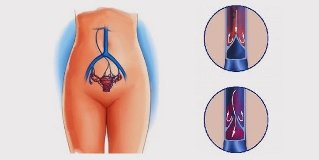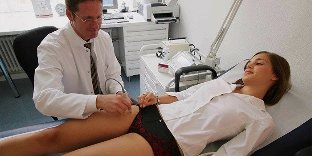You will learn in this article: why the varicose veins of the pelvic region is considered as a disease, and not a kind of varicose veins in the legs, in which this disease can occur and why. Manifestations, and diagnosis of this pathology, how to properly treat the chance of cure.

The pelvic varicose veins – that is, the weakening of the internal wall or external venous blood vessels of the pelvic region, leading to an excessive expansion of their diameter. Varicose changed veins are not able to provide the blood flow of the pelvic organs, which results in the stagnation and the total destruction of the vascular wall. As a result, the violation of the structure and function female sex system.
The initial stages of the disease cause little discomfort in the area of the vulva and the abdomen. Women with pelvic varicose veins are tormented by pains, various gynecological diseases, sterile, cosmetics have a defect in the form of a tortuous extended venous nodes on the perineum, lips, or the vulva.
The disease can be completely cured, but relapse is necessary for life prevention. Dealing with this issue jointly by the vascular surgeons, obstetrician gynaecologists.
Varicose vein pelvic in men as in women, it does not happen. But this disease is varicocele. The mechanisms and the manifestations are similar to those of if pelvic varicose veins. The extension of the vein occurs in the left testicle and on the route of the spermatic cord, as in the left of the vienne, eggs, stagnation of the blood. It has the covered back of the left renal vein, which empties vienna.
The essence of the pathology, as much as it is serious
Outside and inside of the female genital organs well does provides. In order to provide a blood flow need a powerful network of blood vessels venous. Therefore, the venous system of the pelvis in women is well developed. Each vienna has heavy-walled, equipped with valves, is closely related to the course of the veins. All of this is smoothly working the venous network of the pelvic region which collects blood from the perineum, reproductive organs (vulva, vagina), structures (ovaries, uterus), and the transports in the bottom Polow vienna.
Varicose veins modified from the vienna basin differ from the health so that they:
- Expanded diameter;
- Full of blood;
- Too convoluted;
- Have roughened in the form of nodes;
- Flabby and weak.
The pelvic veins affected by varicose veins, can collect the blood of the external genital and other organs, but can normally carry more large vessels (vena cava). As a result, the blood stagnates in the basin, and penetrates into the vein wall, hits the tissues which must not. They become swollen, inflamed and lose their function.
But the more varicose vein pelvic dangerous:
- The various violations of the ovary;
- Of the uterus bleeding, and the different mental disorders;
- The sterility, the threat of interruption of pregnancy and the impossibility of a delivery;
- The formation of blood clots in the wells of light varicose veins, altered veins, threatening their margin places of education and migration in the heart and the blood vessels of the lungs. What are the most dangerous of the fatal complication – pulmonary embolism (pe).
The reasons
Mainly the pelvic varicose veins happen mature women:
- Up to 20 years – 20%;
- 20 to 30 years old – 30%
- 30 – 45 years – 50%
Mechanisms of varicose veins of the renaissance of the venous system of the pelvis:

- (80%). They are the larger trunk veins, which collect blood from the uterus and from the ovary and transport it directly in to the hollow (right) kidney (left) of vienna. If occurs a failure, it's blocking the exit.
- Uniform of the weakening or destruction of the vein wall of all pelvic varicose veins – they are both dilate and are not able to decrease to propel the blood in the recovery of departments.
- The reverse of blood flow in a deep vein of the thigh, in the area of sexual vienna, which is the collection of blood from the perineum and the vulva, prevents the flow. As a result, the pressure in it increases, and its trunk and all tributaries varicose veins dilate.
The direct causes of the execution of these mechanisms can be:
- Congenital weakness or dysplasia (underdevelopment) of the venous wall and valves.
- Hormonal adjustment in the body of the woman (puberty, pregnancy, menopause, diseases of the ovary).
- Frequent inflammatory processes, endometriosis, operations, adhesions in the pelvis.
- Transferred to thrombosis and thrombophlebitis of the pelvic veins.
- A physical work.
- Prolonged stay in a sitting or lying position.
- The excess of weight.
- The pregnancy and childbirth.
- Regular interruption of sexual relations for many years, in particular in the absence of orgasm.
- The curvatures of the uterus to the rear or the front.
- The pelvic tumor.
- Prolapse of the uterus.
The degree of varicose veins – classification
For anatomical reasons (the prevalence) varicose veins pelvic are divided into three types:
- Venous plethora in the basin;
- Perineal varicose veins, etc
- Combined form.
To take account of the nature of the pathological changes disease is divided into three degrees:
- The first – the vessels of any organ plexus of the pelvic ring does not exceed the diameter of 0.5 cm, redundant, convoluted.
- The second – diameter of the veins increases up to 1 cm, the process is widespread not only on the plexus organs(uterine, ovarian), but near of them (okolomatocnah fiber).
- The third expansion (ectasia) of more than 1 cm, affecting all the vessels – intraorganic, about bodies, and the trunk (a trunk ovarian vienna).
The greater the degree of the disease, the more extensive of vienna and the heaviest of the stagnation of the blood in the basin.
The characteristic symptoms
Women with pelvic varicose veins noted:
- Permanent or recurring pain in the lower abdomen, aggravated in the evening and after an effort mainly in the second half of the cycle (to the nearest month). 3 the degree of pain can be very sharp.
- Itching, burning sensation, swelling and cyanosis of the genital organs.
- Painful menstruation and of the sexual act.
- Menstruation and uterine bleeding, cycle irregular.
- The inability to get pregnant.
- Thickened convoluted vienna in the perineal area and the lips.
- Frequent pain in urination.
- Pronounced manifestations of the premenstrual syndrome.

The diagnosis
To confirm the diagnosis through:
- ULTRASOUND through the abdomen and through the vagina (transvaginal), with the help of the sensors – doppler, and duplex treatment of pelvic varicose veins. The most simple and informative method.
- Endovascular phlebography – introduction of drugs in the ovary vienna.
- A ct scan with contrast.
- Diagnostic laparoscopy.
The methods of treatment
Varicose veins of the pelvic region to jointly deal with the vascular surgeons or obstetrician-gynaecologists. According to the modern concepts of treatment consists of these areas:
- The standardization of ways of life;
- Conservative drug treatment;
- The Compression and other therapy;
- A surgical treatment.
Heal pelvic varicose veins you. To do this, the experts provide a customized plan of care, the sick, the women have to life to respect the institutions of the recommendations.
1. The standardization of lifestyles
Because a bad mode of life is the condition and the immediate cause of pelvic varicose veins varicose veins, its standardization will help to heal:
- Eliminate a long stay in a standing or seated position (more than 2-3 hours without interruption).
- Do not lift heavy weight, and give up a year of intense work.
- In the course of the day, follow the unloading of the gym to the pool (for the years of birch, a bike or simply soak for 10 to 15 minutes of raised above the level of the body to a basin.
- Reduce the weight (obesity).
- Do not take a hot bath, replace with shower.
- Avoid alcohol and smoking.
2. Drug therapy
The treatment of varicose veins pelvic varices of any degree is not possible without medical treatment support. In the first degree, it is the main treatment event, during the second and third complete the full course of treatment.
Use of these drugs:
- Specific drugs enhance the vessels venous.
- Anticoagulants – blood flow, to facilitate its advancement through the vessels.
- Products that improve the microcirculation.
Other groups of drugs are administered, taking account of differences in the body:
- Preparations of female sex hormones (at the dishormonal violations).
- Analgesic and anti-inflammatory.
- The medicines to stop the blood – hemostatics drugs for the treatment of uterine hemorrhage.
3. Compression therapy
One of the effective ways in the treatment of varicose veins in the area of the vulva and perineum is the impact of the compression. The principle of this method is similar to the use of elastic bandages during the varicose veins of the feet. Compression (compression) of the superficial veins of the exterior promotes the evacuation of the blood. To create such an effect capable of menus for tights or shorts compression therapeutic hosiery. You can buy them in pharmacies, specialized stores, salons, health care products, individually, by choosing the size and the compression force.
Sclerotherapy – puncture varicose veins extended from vienna, with the introduction in the light of the treatments that cause the adhesion. This treatment takes place outdoors (subcutaneous) pelvic varicose veins without a hospital admission. Internal of vienna can also be treated, but this procedure is technically more complex and is carried out in operating conditions.
4. The surgical treatment
Varicose vein pelvic best to treat surgically when:
- 2-3 degrees of the disease;
- Rapid progression of the disease;
- The planning of the pregnancy;
- Expressed pain syndrome;
- Permanent uterine bleeding and other gynecological disorders.
The main types of operations in the pelvis the varicose veins:
- Laparoscopic – special operation through perforations of the stomach. Make the dressing, the intersection or the removal of ovarian vienna. Therefore, eliminates the reverse casting of blood on it.
- The removal of varicose veins varicose veins through small punctures or incisions of the skin are removed modified under the skin of vienna, bandaged outside sexual vienna to the confluence in the blood vessels.
- Gynecological intervention – the removal of tumors, the elimination of the curvatures of the uterus.

Forecast
If everything is not treated varicose dilated veins of the pelvis, with the time they have even more expansion (95%) risk of dangerous complications. The other 5% of women with subcutaneous varicose veins crotch of 1 to 2 degrees, he appeared after the birth, the pathology does not increase, but will never be of itself.
If you cure the disease, you can get a full recovery (10% to 50% depending on the degree) or a significant improvement of the state (45-50%), in particular in the case of a combination of surgical techniques with a conservative. But in all cases after a full course of treatment must be increased to life, the prevention is to comply with the recommendations on the mode of life, periodic counter, or compression of support veins weakened.




































